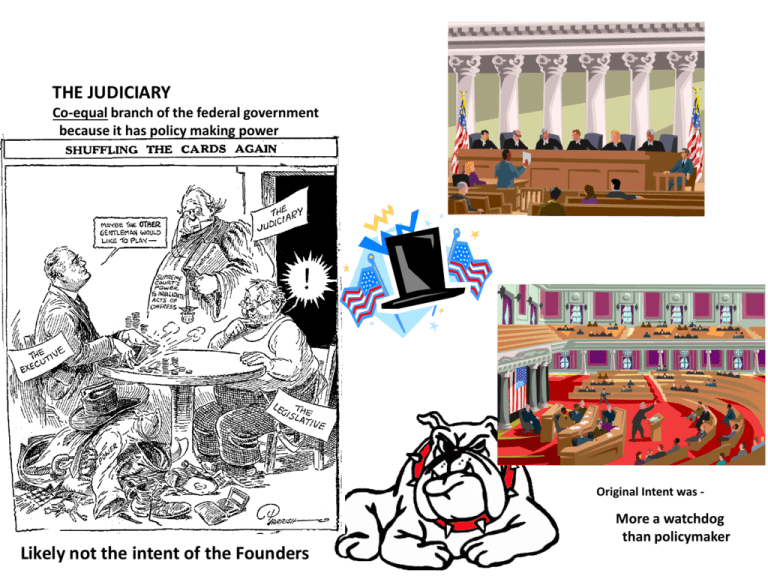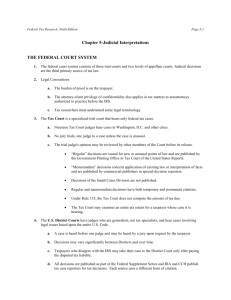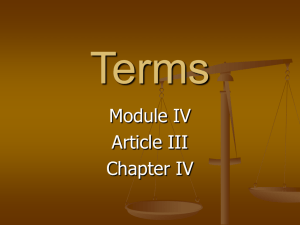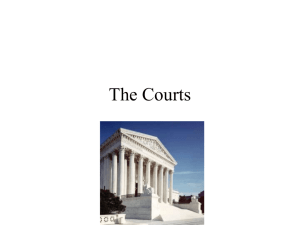court - Haiku for Ignatius
advertisement

THE JUDICIARY Co-equal branch of the federal government because it has policy making power Original Intent was - Likely not the intent of the Founders More a watchdog than policymaker John Marshall 4th Chief Justice of the United States (1801-1835) JUDICIAL REVIEW -Implied but not stated in Article III -Allows courts to rule on the constitutionality of laws and actions- giving them the power to strike down or re-enforce policy, not just apply and interpret it. Judicial Review makes the US system unique Starting with Marbury v. Madison and subsequent cases over the next 35 years, Marshall establishes the courts as a coequal branch of the federal government, and helps to make the federal government sovereign of the states. writs of mandamus are a power of the US courts not because of the Judiciary Act of 1789 but because of the concept of judicial review Importance of precedence stare decisis- let the decision stand is the first standard of appellate interpretation The USA has several types of law as the basis for its legal system 1. Common Law 2. Statute Law – enacted by Congress 3. Administrative Law- from regulation and adjudicatory power given to federal agencies 4. Constitutional law – based on interpretation of the Constitutions JURISDICTION: power to apply and interpret legal power ORIGINAL JURISDICTION: court case must first begin in this court. APPELLATE JURISDICTION: court which rules on the proper application of the law or if the process and procedures were correctly done Structure of the Federal Court System UNITED STATES FEDERAL COURT SYSTEM * •these are known as legislative courts , which do not have the protections of Article III = the constitutional courts also note, if a state court case involves the interpretation of a US Constitutional question, it enters at the US Circuit Court of Appeals. (SCOTUS can even issue a writ of certiorari and take up the question from a state court.) =12 PARTICIPANTS IN THE JUDICIAL SYSTEM: • • • • • judge litigants lawyers jury audience: media; interest groups; the public LITIGANTS: plaintiff – bringing charges, seeking “justice” defendant – one being charged Criminal law = violations, injury, harm against society violation of a specific law - imprisonment and or fines will result from conviction Civil law = accusation of a violation of one’s rights by another. Person vs. Person finding against or conviction results in payment for compensation. To sue : tort Hennessy v. Franzinger (2014) - civil case regarding an alienation of affection United States v. Booth (1865) – criminal case involving the assassination of Abraham Lincoln Basic criterion to bring a lawsuit is called STANDING - there are real people involved - there must be a real controversy involved between the parties - there must be real harm broadening of the notion of standing has come to make possible CLASS ACTION SUITS a single individual or small group can represent all others similarly suited in 1954, nine year old Linda Brown represented all black students from several school districts around the USA suing re: discrimination in public education. Brown v. Board of Education of Topeka Courts have imposed requirements on those seeking financial compensation thru class action suits: 1. required to make a significant effort to contact all similarly situated - seen the TV commercials: “Have you been harmed by the use of the Acme widget?!” “Call Dewey, Cheetam, and Howe at 800-555-5555” 2. tort reform legislation – against “frivolous” lawsuits Liebeck v. McDonald’s Corporation LAWYERS - advocates for the contending parties. litigators – lawyers who actually argue the case in the court before a jury/judge prosecutors – in criminal cases, lawyers for the government solicitor general – advocates for the US government before SCOTUS US Attorney - chief prosecutor for the US for a district court (94) Assistant US Attorneys – arguing most of the cases when the US is sued - these also serve as defense lawyers Public Defenders – appointed for the indigent Gideon v. Wainwright (1964) The JURY: grand jury: two dozen or more citizens who hear prosecutory charges issue an indictment: formal accusation and call to trial petit jury (trial jury): 12 citizens who hear evidence and arguments decide to acquit or to convict voir dire: the process done by lawyers and judge to pick jury Important to note : the accused can opt not to have case heard by jury today less trials are done by jury. high frequency of plea bargaining- parties working out a compromise to avoid trial in tort cases: parties often hire an arbitrator and agree to his/her findings. The AUDIENCE: interest groups actively seek litigants and their causes to support. interest group sponsored cases are called TEST CASES which are about questioning some point of the law. Two important such groups are NAACP and the ACLU. besides sponsoring a cause, groups also seek to influence the appellate court thru amicus curiae briefs (legal arguments) for the court to consider in formulating its opinion. These groups have no association with the case other than interest in the court’s ruling. Media: always has an influence – so much so that courts can limit its coverage of a trial gag orders and juries get sequestered. The JUDGE: guide the decision making in an impartial manner - make procedural rulings - instruct the jury - validate the final decision of acquittal or conviction - establish the “remedy” = what is the result/ solution to the case THE JURISDICTION OF THE FEDERAL COURTS dual court system exists in USA – thanks to federalism: state and national courts certain cases are given to the federal courts by the Constitution, and the rest to the state courts by the notion of reserved powers and the X and XI Amendments federal question cases: cases “arising under the Constitution, the law of the US, and treaties” and diversity cases: cases involving citizens of different states. (serve as neutral venue) dual sovereignty: state and feds can prosecute same person for same conduct The Process 1. SCOTUS 2. Court of Appeals 3. District court sovereign immunity: cannot sue US without its permission constitutional question: state cases can be appealed to SCOTUS if an application of a state law or power is viewed as a violation of the Constitution (civil liberty/civil right issues) application of Constitutional requirements on the states is called: incorporation based on “equal protection and due process” of XIV Amend. THE SELECTION OF JUDGES Constitution is silent about qualifications ! All we get is the requirement to exhibit “good behavior” Nomination Process • POTUS nominates • SENATE confirms under the power of “advise and consent” • but there are 100s of seats at the district and appellate level and nine justices on the SCOTUS → no single POTUS makes all appointments because of lifetime tenure. But some POTUS will make more than another. If a POTUS had to appoint all , it would have to be a full time job! So here’s the really skinny: Staffers in the WHO specialize in finding candidates - recommendations from DOJ FBI Congress ABA and other interest groups, even other sitting judges. -The process on the district and appellate levels is dominated by the tradition: SENATORIAL COURTESY The Senate rejects if the senior Senator of the majority party, from the state to be served in, objects to candidate for a district court. For an appellate judgeship – if both senators from the nominee’s home state object = Senate Rejection Nomination to the district courts are fairly cut and dry because of Courtesy, but for appellate and especially SCOTUS it is much more political and ideologically driven. The powerful role of the Senate Judiciary Committee - all nominees are interviewed - if not recommended by the Committee = Senate rejects Why are you nominated? 1. Political Ideology is good fit with POTUS (?) 2. Party and Personal Loyalties 3. Acceptability to the Senate 4. Judicial experience 5. Race and Gender 6. “Litmus Test” HOW THE SUPREME COURT (SCOTUS) WORKS 1. 2. 3. 4. Resolves conflicts between states Maintains national supremacy Ensures uniformity in the interpretation of national laws Determines the constitutionality of laws and government actions (policy) SCOTUS does more than decide specific cases. In the end, it shapes policy as profoundly as any law passed by Congress or any action taken by the president SELECTION OF CASES issuing of a writs of certiorari = “CERT” via the “RULE of 4” - 9 justices seat in panels reviewing cases petitioning for cert - the panel of 4 justices decide if SCOTUS will hear the case NB: law clerks doing the research SCOTUS HAS TOTAL CONTROL OF ITS AGENDA – IT WILL HEAR ONLY A HANDFUL OF THOSE PETITIONED STARE DECISIS is always in play SCOTUS in session from First Monday in October to early June BRIEFS and ORAL ARGUMENTS brief= printed legal arguments and cited relevant precedents of the litigants are read by SCOTUS ( included in this reading can be amicus curiae briefs) oral arguments are then scheduled: Mondays, Tuesdays, and Thursdays each litigator has only 30 minutes to make the oral argument - the justices may ask questions and make comments during your 30 minutes ! THE CONFERENCE Wednesday afternoons and all day Friday SCOTUS discuss and “vote” on the cases Chief Justice moderates these discussions. When he feels that they are done, each justice is asked to give his or her concluding views. OPINIONS once a conference decision is made, the formal opinion ( statement of legal reasoning behind the decision) needs to be created. majority opinion: official opinion of the court the senior member of the court in the majority assigns responsibility for its writing. dissenting opinion: statement of those justice(s) in disagreement with the majority senior member of the opposition assigns its writing. concurring opinion: written by a justice who agrees with the majority conclusion, but for other reasons than those stated in the majority opinion All opinions are published. The dissent may be used - citing legal reasoning and precedent for some future case or issue, especially if the original majority opinion gets reversed. The author of an opinion often gives it its worth down through history. The “vote” of the Court is not formally calculated. It is deduced from who writes what or who endorses what opinion. 9-0 8-1 7-2 6-3 5-4 ( weakest- a candidate for reversal) Implementation of a decision judicial implementation: translation of a decision into actual policy which affects the behavior of others No enforcement = Courts rely on the power possessed by the other branches if POTUS or Congress are gung-ho - it happens Usually it is not on their agendas, but it gets done thanks to the bureaucracy which really loves to do its job. (conditions of aid/regulations) The problem comes if the decision requires the co-operation of several officials or the wide extent of the country. desegregation school prayer Corrigan’s opinion: Courts often speak for “the silent” and most of us expect and want the Courts to do so – because as citizens we should but do not – which is both gratifying but also quite embarrassing. We get to play Pilate ! THE COURTS AND DEMOCRACY - the courts are the least democratic - appointment not election - life tenure - decision can only be reversed by a higher court, or amending the Constitution But … POPULAR INFLUENCE • Judges chosen because of a political connection/bias to a president • Judges read newspapers, go to Home Depot, worry about their reputations, read their mail – worry more about peer opinion • Influenced by the fact of their lack of enforcement power. POLITICAL IDEOLOGY • not “babes in the wood” or pristine druids of the law had been and are are members of political parties and activities • “above politics”, but are Republicans and Democrats conservative and liberal ( and moderate) CONSERVATIVES Human beings – they have opinions; ethics, moral code BLOODS” Roberts* Scalia Alito Thomas “Swing Vote” Kennedy “CRIPS” Breyer Ginsberg Kagan Sotomayor LIBERALS CONSTRAINTS ON THE POWER OF THE FEDERAL COURTS JUDICIAL REVIEW makes US judges the most powerful judges in the world’s modern democracies but … 1. Adversarial system - two equal parties present their arguments to an impartial arbiter need for neutrality → more passive role for the judge 2. Justiciable dispute requirement: need for “standing” must be resolvable by legal methods real issue/real harm 3. Political question doctrine: for the sake of constitutional principles, some disputes need to be worked out between POTUS and Congress not in a court room. Classic Checks and Balances: • POTUS controls nature of courts by appointment power • Senate must confirm appointments via “advise and consent” • Congress can alter the structure of the courts: # of courts; # judges; jurisdictions • Congress can impeach federal judges: 3 since 1989 • Congress and the states can amend the Constitution when a Court finds a law or action unconstitutional. THE POLICY MAKING POWER most cases decided by the federal courts only apply existing law to specific cases yet courts do make policy (take government action) on both small and big issues. There exists quite a contentious debate about the extent of policymaking by the courts JUDGE MADE LAW Strict constructionist JUDICIAL RESTRAINT Minimal policy making Judicial activist vs. JUDICIAL ACTIVISM Policy making encouraged; new (modern) interpretations needed - Judiciary the least democratic - Constitution needs to be understood in its original context - judges aren’t policy experts, so don’t make policy! - other branches unwilling or incapable of correcting injustices e.g. Minority rights in a representative democracy under an electoral system based on plurality It is important to realize how political ideology affects policy making power: BUT liberals are not always activists and conservatives not always strict-constructionists We are under a Constitution, but the Constitution is what the judges say it is. Chief Justice Charles Evans Hughes (1930-1941) Justice Hughes








